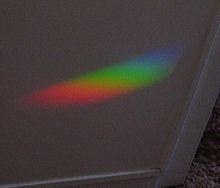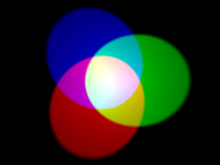- Color mixing
-
There are two types of color mixing: Additive and Subtractive. In both cases there are three primary colors, three secondary colors (colors made from 2 of the three primary colors in equal amounts), and one tertiary color made from all three primary colors.
Contents
Additive Mixing
Additive mixing of colors generally involves mixing colors of light. In additive mixing of colors there are three primary colors: red, green, and blue. In the absence of color or, when no colors are showing, the result is black. If all three primary colors are showing, the result is white. When red and green combine, the result is yellow. When red and blue combine, the result is magenta. Additive mixing is used in television and computer monitors to produce a wide range of colors using only three primary colors.
Subtractive Mixing
Subtractive mixing is done by selectively removing certain colors, for instance with optical filters. The three primary colors in subtractive mixing are yellow, magenta, and cyan. In subtractive mixing of color, the absence of color is white and the presence of all three primary colors is black. In subtractive mixing of colors, the secondary colors are the same as the primary colors from additive mixing, and vice versa. Subtractive mixing is used to create a variety of colors when printing on paper by combining a small number of ink colors, and also when painting. The mixing of pigments does not produce perfect subtractive color mixing because some light from the subtracted color is still being reflected. This results in a darker and desaturated color compared to the color that would be achieved with ideal filters.
Importance to vision
Additive color mixing—red and green combining to make yellow, for example, or blue and yellow producing white—runs counter to the commonsense observation that, for example, yellow paint plus cyan paint makes green paint. In this case, one must understand that the wavelengths of light that reach the eye are often selected via these more intuitive subtractive processes: for example, cyan paint appears to our eye as cyan because it absorbs red wavelengths, and a yellow paint appears yellow because it absorbs blue wavelengths. When white light falls on a combination of cyan and yellow, then, both red and blue are absorbed, and green is reflected to the eye.[1]
See also
- Color theory
- Subtractive color
- Additive color
- Impossible colors
External links
- Interactive Java applet on the additive mixing of RGB colors by Wolfgang Bauer
- Interactive Java applet on the subtractive mixing of CYM colors by Wolfgang Bauer
References
- Macaulay, David and Neil Ardley (1988). The New Way Things Work. London: Dorling Kindersley Ltd. ISBN 0395938473.
- ^ "Sensory Reception: Human Vision: Structure and Function of the Eye" Encyclopaedia Britannica, vol. 27 1987
Wikimedia Foundation. 2010.



